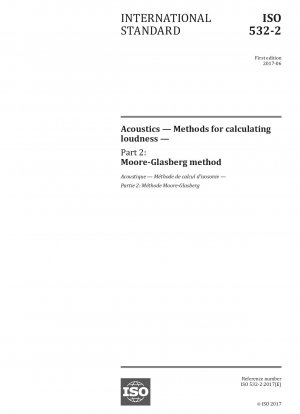ISO 532-2:2017
Acoustics - Methods for calculating loudness - Part 2: Moore-Glasberg method
- Standard No.
- ISO 532-2:2017
- Release Date
- 2017
- Published By
- International Organization for Standardization (ISO)
- Latest
- ISO 532-2:2017
- Scope
- This document specifies a method for estimating the loudness and loudness level of stationary sounds as perceived by otologically normal adult persons under specific listening conditions. It provides an algorithm for the calculation of monaural or binaural loudness for sounds recorded using a single microphone, using a head and torso simulator, or for sounds presented via earphones. The method is based on the Moore-Glasberg algorithm. NOTE 1 Issues of binaural calculations are discussed in Annex A. NOTE 2 Users who wish to study the details of the calculation method can review or implement the source code, which is entirely informative and provided with this document for the convenience of the user. This method can be applied to tones, broadband noises and complex sounds with sharp line spectral components, for example transformer hum or fan noise. NOTE 3 It has been shown (see Reference [15]) that this method provides a good match to the contours of equal loudness level as defined in ISO 226:2003 and the reference threshold of hearing as defined in ISO 389-7:2005. The evaluation of the harmful effect of sound events is outside the scope of this document.
ISO 532-2:2017 Referenced Document
- DIN 45631:1991 Procedure for calculating loudness level and loudness
- IEC 60050-702:1992 International electrotechnical vocabulary; chapter 702: oscillations, signals and related devices
- IEC 61260-1:2014 IEC 61260-1: Electroacoustics - Octave-band and fractional-octave-band filters - Part 1: Specifications
- IEC 61672-1:2013 Electroacoustics - Sound level meters - Part 1: Specifications
- ISO 11200:2014 Acoustics - Noise emitted by machinery and equipment - Guidelines for the use of basic standards for the determination of emission sound pressure levels at a work station and at other specified positions
- ISO 11904-1:2002 Acoustics - Determination of sound immission from sound sources placed close for the ear - Part 1: Technique using a microphone in a real ear (MIRE technique)
- ISO 1996-1:2016 Acoustics - Description, measurement and assessment of environmental noise - Part 1: Basic quantities and assessment procedures
- ISO 226:2003 Acoustics - Normal equal-loudness-level contours
- ISO 3740:2000 Acoustics - Determination of sound power levels of noise sources - Guidelines for the use basic standards
- ISO 389-7:2005 Acoustics - Reference zero for the calibration of audiometric equipment - Part 7: Reference threshold of hearing under free-field and diffuse-field listening conditions
- ISO 532:1975 Acoustics; Method for calculating loudness level
- ISO 80000-8:2007 Quantities and units - Part 8: Acoustics
- ISO 9612:2009 Acoustics - Determination of occupational noise exposure - Engineering method
- ISO/IEC GUIDE 98-3:2008 Uncertainty of measurement — Part 3: Guide to the expression of uncertainty in measurement (GUM:1995)
ISO 532-2:2017 history
- 2017 ISO 532-2:2017 Acoustics - Methods for calculating loudness - Part 2: Moore-Glasberg method
